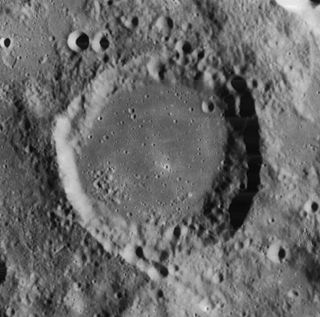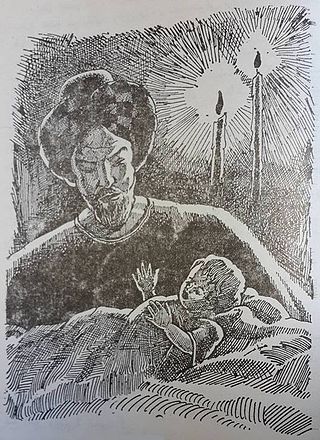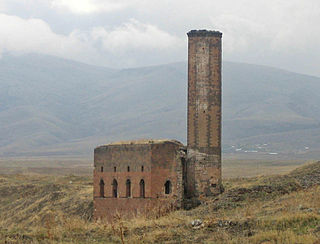Related Research Articles
Abu al-Fida Isma'il ibn Umar ibn Kathir al-Dimashqi, known simply as Ibn Kathir, was an Arab Islamic exegete, historian and scholar. An expert on tafsir, tarikh (history) and fiqh (jurisprudence), he is considered a leading authority on Sunni Islam.

The Bahri Mamluks, sometimes referred to as the Bahri dynasty, were the rulers of the Mamluk Sultanate of Egypt from 1250 to 1382, following the Ayyubid dynasty. The members of the Mamluk ruling class were purchased as slaves (mamluks) and manumitted, with the most powerful among them taking the role of sultan in Cairo. While several Bahri Mamluk sultans tried to establish hereditary dynasties through their sons, these attempts were ultimately unsuccessful, with the role of sultan often passing on to another powerful Mamluk.

Abulfeda is a lunar impact crater located in the central highlands of the Moon. To the northeast is the crater Descartes, and to the south-southeast is Almanon. To the north is the crater Dollond. A chain of craters named the Catena Abulfeda runs between the southern rim of Abulfeda and the north rim of Almanon, then continues for a length of 210 kilometers across the Rupes Altai. The crater was named for 14th century Kurdish historian Ismael Abul-fida.

Izz al-Din Aybak was the first of the Mamluk sultans of Egypt in the Turkic Bahri line. He ruled from 1250 until his death in 1257.

Shajar al-Durr, also Shajarat al-Durr, whose royal name was al-Malika ʿAṣmat ad-Dīn ʾUmm-Khalīl Shajar ad-Durr, was a ruler of Egypt. She was the wife of As-Salih Ayyub, and later of Izz al-Din Aybak, the first sultan of the Mamluk Bahri dynasty. Prior to becoming Ayyub's wife, she was a child slave and Ayyub's concubine.
Anas ibn Mālik ibn Naḍr al-Khazrajī al-Anṣārī was a companion of the Islamic prophet Muhammad. He was nicknamed Khadim al-Nabi for serving Muhammad for ten years.

Muḥammad Abū’l-Qāsim Ibn Ḥawqal, also known as Abū al-Qāsim b. ʻAlī Ibn Ḥawqal al-Naṣībī, born in Nisibis, Upper Mesopotamia; was a 10th-century Arab Muslim writer, geographer, and chronicler who travelled from AD 943 to 969. His famous work, written in 977, is called Ṣūrat al-’Arḍ. The date of his death, known from his writings, was after AH 368/AD 978.
Ibn al‐Bannāʾ al‐Marrākushī, full name: Abu'l-Abbas Ahmad ibn Muhammad ibn Uthman al-Azdi al-Marrakushi, was a Arab Muslim polymath who was active as a mathematician, astronomer, Islamic scholar, Sufi and astrologer.

al-Malik al-Afdal Najm al-Dīn Ayyūb ibn Shādhi ibn Marwān, or simply Najmadin, was a Kurdish Mercenary and politician from Dvin, and the father of Saladin. He is the eponymous ancestor of the Ayyubid dynasty.
Abū’l-Ḥasan ʻAlī ibn Ismāʻīl, known as Ibn Sīdah, or Ibn Sīdah'l-Mursī, (c.1007-1066), was a linguist, philologist and lexicographer of Classical Arabic from Andalusia. He compiled the encyclopedia al-Kitāb al-Mukhaṣṣaṣ (المخصص) and the Arabic language dictionary Al-Muḥkam wa-al-muḥīt al-aʻẓam (The Great and Comprehensive Arbiter". His contributions to the sciences of language, literature and logic were considerable.
An-Nasir Yusuf, fully al-Malik al-Nasir Salah al-Din Yusuf ibn al-Aziz ibn al-Zahir ibn Salah al-Din Yusuf ibn Ayyub ibn Shazy, was the Ayyubid Kurdish Emir of Syria from his seat in Aleppo (1236–1260), and the Sultan of the Ayyubid Empire from 1250 until the sack of Aleppo by the Mongols in 1260.
Ṣāʿid al-Andalusī, in full Abū al-Qāsim Ṣāʿid ibn Abū al-Walīd Aḥmad ibn Abd al-Raḥmān ibn Muḥammad ibn Ṣāʿid ibn ʿUthmān al-Taghlibi al-Qūrtūbi, was an Arab qadi of Toledo in al-Andalus, who wrote on the history of science, philosophy and thought. He was a mathematician and scientist with a special interest in astronomy and compiled a famous biographic encyclopedia of science that quickly became popular in the empire and the Islamic East.
Abū al-Makārim Hibat Allāh ibn Zayn al-Dīn ibn Jumayʿ was an Egyptian Jewish physician, chief physician at the court of Saladin.
Husam ad-Din Muhanna ibn Isa was the Arab lord of Palmyra and amir al-ʿarab under the Mamluk Sultanate. He served between 1284 and his death, but was dismissed and reinstated four times during this period. As the chieftain of the Al Fadl, a clan of the Tayy tribe, which dominated the Syrian Desert, Muhanna wielded considerable influence among the Bedouin. He was described by historian Amalia Levanoni as "the eldest and most senior amir" of the Al Fadl during his era.
Abū Shāma Shihāb al-Dīn al-Maḳdisī was an Arab historian.

Spread of Islam among Kurds started in the 7th century with the Early Muslim conquests. Before Islam, the majority of Kurds followed a western Iranic pre-Zoroastrian faith which derived directly from Indo-Iranian tradition, some elements of this faith survived in Yezidism, Yarsanism and Kurdish Alevism. When Islam first appeared, the Kurds were divided between the Byzantine and Sassanian Empires. The term "Kurd" back then referred to any Iranian nomad from any Iranian ethnic group whether in central Asia or western Iran regardless of geographic location or Iranian ethnicity. Jaban al-Kurdi and his son Meymun al-Kurdi were the first Kurds who converted to Islam and Khalil al-Kurdi as-Semmani was one of the first Kurdish tabi'uns. Mass conversion of Kurds to Islam didn't happen until the reign of Umar ibn Al-Khattab, second caliph of the Rashidun Caliphate between 634-644. The Kurds first came into contact with the Arab armies during the Arab conquest of Mesopotamia in 637. The Kurdish tribes had been an important element in the Sasanian Empire, and initially gave it strong support as it tried to withstand the Muslim armies, between 639 - 644. Once it was clear that the Sassanians would eventually fall, the Kurdish tribal leaders one by one submitted to Islam and their tribe members followed in accepting Islam. Today the majority of Kurds are Sunni Muslims, and there are Alevi and Shia minorities. Sunni Muslim Kurds are mostly Shafiʽis and Hanafis.

Al-Ayoubi,, is the name of a prominent Levantine family of royal and noble lineage, dating back to the 12th century. Having originated in the ancient Armenian city Dvin,
Abu al-Tufayl Amir ibn Wathila al-Kinani was one of the companions of the Islamic prophet Muhammad and of a number of Shia imams. He was also a poet. Abu al-Tufayl went to Kufa during the reign of Hudhayfah ibn al-Yaman and then to Al-Mada'in. For many years, he was a companions of Ali. Abu al-Tufayl also studied scientific matters from Ali bin Abi Talib. After the death of Ali, he returned to Mecca and stayed there to the end of his life, around 102/732.
References
Citations
- ↑ Encyclopaedia Islamica. 16 October 2015.
- ↑ Gibbs (1986), p. 119
- ↑ Encyclopedia of the History of Science, Technology and Medicine in Non-Western Cultures, (edited by) Helaine Selin, pp. 7–8, Kluwer Academic Publishers, Netherlands, 1997 Identifiants et Référentiels Sudoc Pour L'Enseignement Supérieur et la Recherche – Abū al-Fidā (1273–1331) (in French)
- ↑ Chambers Biographical Dictionary, ISBN 0-550-18022-2, page 5
- ↑ The Moslem World. Nile Mission Press. 1922. Retrieved 5 December 2022.
- 1 2 3 4 One or more of the preceding sentences incorporates text from a publication now in the public domain : Chisholm, Hugh, ed. (1911). "Abulfeda". Encyclopædia Britannica . Vol. 1 (11th ed.). Cambridge University Press. p. 80.
- ↑ The Travels of Ibn Batūta: With Notes, Illustrative of the History , p. 211, at Google Books
- ↑ Gunn, Geoffrey C. (15 October 2018). Overcoming Ptolemy: The Revelation of an Asian World Region. Lanham, Maryland: Lexington Books. pp. 47–48. ISBN 9781498590143.
- ↑ Winfree, Arthur T. (2001). The Geometry of Biological Time (2nd ed.). New York: Springer Science & Business Media. p. 10. ISBN 978-1-4757-3484-3.
- ↑ Helaine Selin, Encyclopaedia of the History of Science, Technology, and Medicine in Non-Westen Cultures (1997), p. 7.
- ↑ Henricus Orthobius Fleischer, Abulfedae historia anteislamica, arabice: E duobus codicibus bibliothecae regiae Parisiensis, 101 et 615, F.C.W. Vogel (1831).
General sources
- Gibb, H. A. R. (1986). "Abu'l Fidā". The Encyclopaedia of Islam. Volume 1: A-B. Leiden: Brill. pp. 118–119.
- Studies on Abul-Fida' al-Ḥamawi (1273–1331 A.D.) by Farid Ibn Faghül, Carl Ehrig-Eggert, E. Neubauer. Institute for the History of Arabic-Islamic Science (Institut für Geschichte der Arabisch-Islamischen Wissenschaften) at the Johann Wolfgang Goethe University, Frankfurt am Main, Germany, 1992.
- Encyclopedie de l'Islam, 2nd ed. E.J. Brill, Leiden and G.P. Maisonneuve, Paris, 1960. (in French)